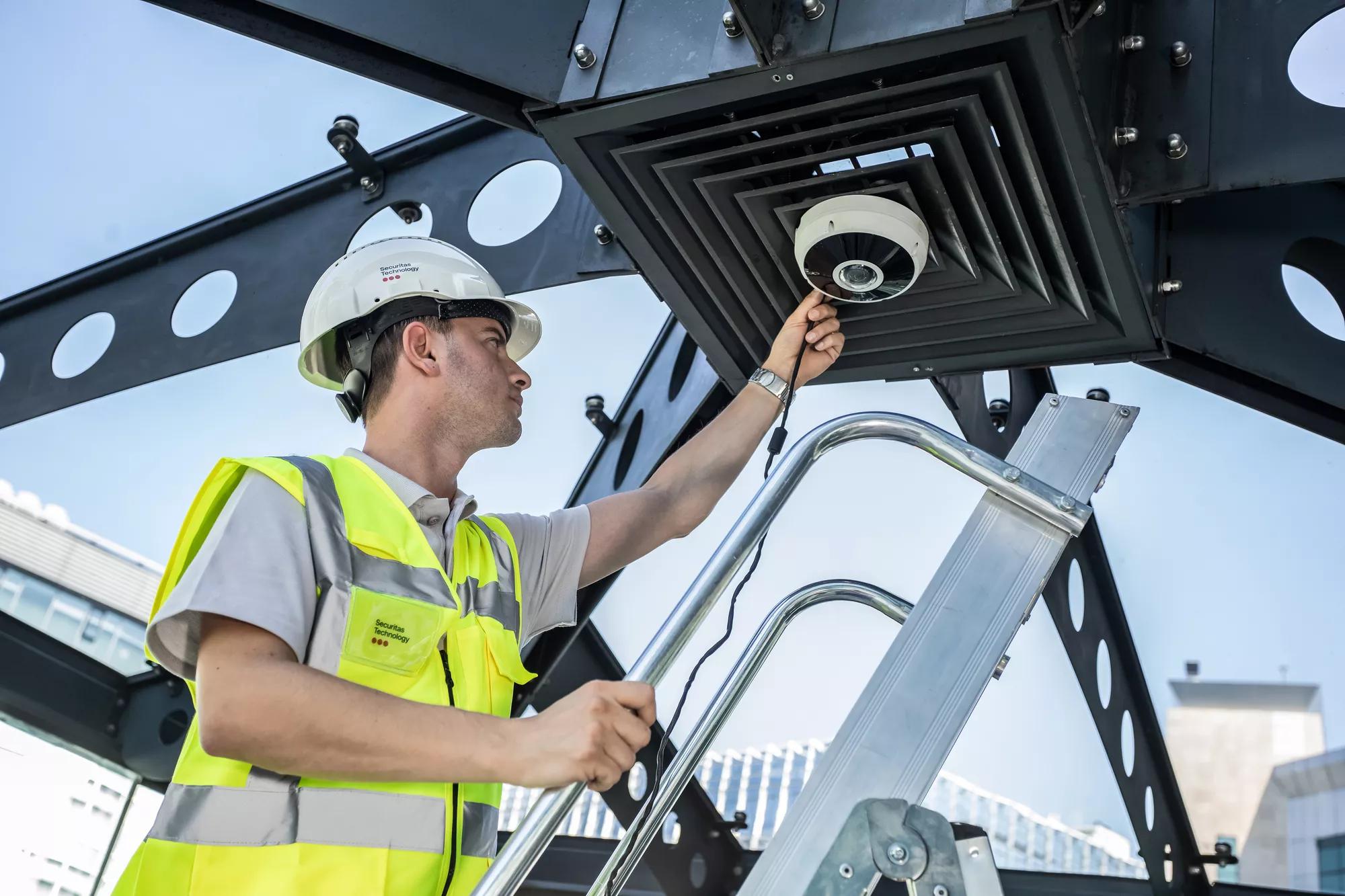The Benefits of a Video Surveillance System

Business Security Now And Video Surveillance’s Role
Following the pandemic of 2020-2022, many organizations are deciding between implementing a hybrid structure or remaining remote. Leaders have new priorities like keeping employees safe, and securing premises even when no one is on site.
According to new research from the Ontic Center for Protective Intelligence, physical security and IT leaders feel more pressure than ever to maintain employee safety.
Since 2023, one-third of physical security and IT leaders say that they’ve received or investigated at least one physical security threat per week. The causes include:
-
Differences between management and employees about safety protocols.
-
A lack of unified digital protective intelligence, resulting in missed threats.
-
A dramatically changing and expanding physical threat landscape, causing an exponential increase in data that’s challenging to manage.
Many believe that the solution to remediating these threats is to unify cyber and physical security. Nearly fifty percent believe the threats they received in 2023 could have been avoided if they’d united their cyber and physical security. This way, cross-functional teams could share knowledge and responsibilities and act on threats.
Ninety-one percent believe that they need a technology-driven industry standard to:
-
Identify
-
Investigate
-
Assess
-
Monitor
-
Manage physical security threats.
In essence, now is the time to invest in physical security transformation. Video surveillance camera systems should be the cornerstone of your security program.
Benefits of Video Surveillance Systems:
A Safer Environment with Video Surveillance
believe the threats they received in 2023 could have been avoided if they’d united their cyber and physical security
believe that they need a technology-driven industry standard to manage physical threats
believe if a missed security threat caused a fatality, their organization would suffer financial and reputational damage
Surveillance Camera Catches Criminals, Onsite and Offsite
Security cameras record footage inside your company buildings and around your premises. Quality cameras should be able to record 24-7. Many cameras have built-in motion sensors that activate your security system at the slightest activity.
Firstly—and most obviously—a video surveillance system is instrumental for organizations to reduce risk and helps prevent crime. Nearly thirty percent of leaders say the greatest physical security threat they’ve experienced last year was building and property vandalism. The second greatest threat was insiders abusing authorized cyber and physical access points.
High-quality surveillance cameras could defend your organization against risks, inside and outside its walls. They can help you gain visibility into the goings-on of your business. You’ll be able to spot thieves, vandals, and intruders easily, as well as employee crime. If you integrate them with access control systems, use the cameras to track who’s entering specific storage areas in ways the human eye can’t.
Naturally, fewer in-office occupants would give vandals more freedom to commit crimes. However, if organizations assume they don’t need security if they work remotely, it leaves more gaps for security threats to invade. When you’re contemplating electronic video surveillance solutions, look for ones with remote monitoring capabilities.
Ask yourself the following questions as you research different video surveillance options:
-
How will I know that the right people are in the building?
-
How will I secure the facility when I’m offsite?
-
If there is a break-in or data breach, how will the system warn me?
-
If I’m working remotely and an onsite crime happens, how quickly can people arrive to mitigate it?
-
Will I need to drive the entire emergency response plan, or can the tool help me?
Human abilities only go so far. If you want optimal security, it’s time to rely less on security guards and prevent false alarms. In addition to protecting your people, you need to defend millions of dollars in proprietary assets and data. Surveillance technology has 24-7 monitoring, panic alarm triggering, and verification to ensure everyone who’s on-premise is supposed to be there.
Video Surveillance Keeps Your Organization’s Status Quo
Secondly, video surveillance helps preserve business continuity. Twenty-seven percent of IT and security leaders say the greatest physical security threat they anticipate in 2024 is supply chain damage and/or disruptions. Two of the biggest causes of supply chain disruptions are cyber breaches and financial risks.
The results of supply chain disturbances mean customers don’t receive orders on schedule and organizations lose revenue. Supply chain disruptions can cost large companies, on average, $184 million a year, says Security Magazine. Sixty-nine percent say that if a missed security threat caused a fatality, their organization would suffer irrecoverable financial and reputational damage. When you have cameras visibly installed, the sight of them can deter criminals and intruders, stopping crime before it can start.
Monitoring your employees doesn’t just mean recording theft. As business.com points out, just two minutes of security video surveillance can tell you a lot about your organization’s operational model. For example, are all of your employees where they need to be? Cameras can be a tremendous asset in workflow monitoring. You can ensure that your employees are being productive and engaged, and also spot areas where your workflow can improve.
Scale Cloud Video Surveillance Along With Your Business
The last thing you want to worry about when growing your business is overhead costs slowing you down.
The solutions of yesteryear were clunky and complex, and they were challenging and expensive to install, maintain, and upgrade. They also involved:
-
Router configuration costs
-
Site labor
-
Software patches and updates
-
Onsite repairs
However, today’s surveillance technologies are much more secure and flexible.
If you go with cloud-based surveillance, you’ll find that it’s much more operable for multiple people from any location than traditional systems are. This is an optimal solution for business owners who can’t hire a full surveillance team. You can access your security more easily from any location and add more users as your organization grows. Besides convenience, multiple different people can monitor security and respond or raise an alert if they’re concerned.
Additionally, cloud video surveillance will preserve your data as your business grows. Since your data will be stored in the cloud and its associated data center, you won’t have to depend on one physical device for surveillance. Cloud-based surveillance systems also offer a great deal in terms of bandwidth, video resolution, and storage. When your surveillance technology has advanced bandwidth management capabilities, it can extend video retention periods or increase or limit resolution.
Security Video Surveillance Can Safeguard Your Data
Surveillance today means so much more than monitoring people or property. You can use your surveillance technology to retain your data. Cloud-based capabilities are the driving force behind this. For example, what if a flood happens or a criminal tampered with one of your cameras? In a traditional system, a physically damaged device or poor network connection could bring the whole system down, rendering your security obsolete.
When you’re running a cloud-based solution, your system is continually backing up to its data center location or storage network. These data centers usually have stringent federal security mandates, privacy guidelines, and other protective measures to guard your data. Security integrators can ensure the connections from the network cameras to the cloud is secure. To further protect your stored data, the integrators can establish strict propriety security protocols to uphold data privacy and integrity.
Surveillance Can Help You Save Money
Adding a new system for surveillance may seem like a heady investment. Actually, if you decide to go with a cloud-based SaaS solution, you can pay month-to-month instead of one large upfront cost. With a good system, you should be able to add features on-demand with minimal impact to your day-to-day operations.
Installing and deploying a cloud-based solution requires less time, materials, and labor than traditional solutions. The right platform will have interconnected technologies. It should be able to automatically update to make sure you are enjoying the full capabilities of the technology. This lessens the need for repairs and expensive, time-consuming system upgrades.
A surveillance system may also help you reduce your insurance costs. Many business insurance providers will offer you discounts for your office if you invest in surveillance cameras. It also shows providers that you’ve taken steps to protect your organization, and they’ll consider your organization less of a liability.
Beyond just purchasing the technology, surveillance can help you avoid significant monetary consequences. Workplace crime costs U.S. businesses $50 billion annually. Even more shockingly, seventy-five percent of employees have stolen from their companies at least once, says techjury.net.
Small-scale incidents can negatively impact a business as well. A good example of this is a false liability claim. Video evidence can help your organization avoid a lawsuit and having to pay unnecessary fines. Conversely, if one of your employees has a legitimate claim but faces opposition from your insurance provider, video evidence can validate the claim.
Surveillance Can Help You Avoid or Mitigate Lawsuits
Camera surveillance footage can be valuable, often indisputable evidence in a legal situation. If an incident like employee violence happens at work, witnesses may have multiple accounts. Video evidence helps you substantiate your claims, or disprove false ones.
However, video surveillance can be complex in legal contexts, particularly when it comes to surveilling employees. Organizations have to balance the company’s interests with employees’ expectations of privacy. Many organizations find that simply informing their employees of surveillance cameras on-premise avoids a lot of problems.
To avoid legal challenges when you’re monitoring employees, some of the SHRM’s recommendations include:
-
Using video surveillance only when justified by a legitimate business purpose (e.g. preventing theft or workplace violence, investigating illegal or improper conduct, or monitoring employee performance).
-
Understanding and complying with state or local laws dealing with video surveillance.
-
Obtaining written employee consent to video surveillance for legitimate business purposes.
-
Training supervisors in the legal issues involving video surveillance.
-
Treating information obtained through video surveillance as confidential and limiting access to video recordings to security personnel or management personnel with a need to know.
Use Surveillance to Solve Today’s Business Problems
The business security landscape has changed dramatically in the past two years alone. Organizations have to uphold security whether their staff works remotely all of the time or some of the time. They also have to manage growing volumes of data and find out how to keep security in lockstep with business growth. By providing 24-7 monitoring, data protection, and indisputable evidence, video surveillance systems can be critical assets in accomplishing such goals.
Disclaimer: By using the Blog section of this website (“Blog”), you agree to the terms of this Disclaimer, including but not limited to the terms of use and our privacy policy. The information provided on this Blog is for information purposes only. Such information is not intended to provide advice on your specific security needs nor to provide legal advice. If you would like to speak to a Security representative about your specific security needs, please contact us.























